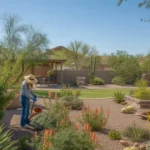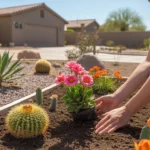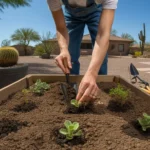As the chill of winter fades and spring’s warmth returns, it’s time to revive your Queen Creek garden from its seasonal slumber. With some targeted cleanup, pruning, planting, and irrigation adjustments, you can set the stage for a bountiful and beautiful growing season. Follow these expert tips to help your desert garden spring back to life.

Clear Out Winter’s Debris
Before you can plant or prune, take time to thoroughly clean up your garden beds and yard. Remove any remaining dead annuals, fallen leaves, and broken branches. Keep an eye out for unwelcome winter guests like weeds or pests that may have taken up residence.
One pro tip is to avoid disturbing the soil too much during your spring cleaning. “Work gently around existing plants and avoid over-cultivating the soil, which can disrupt beneficial microbes and earthworms that help maintain soil health,” advises a local Queen Creek gardening expert.
As you clear debris, consider starting a compost pile if you don’t have one already. Leaves, small twigs, dead plant matter, and grass clippings make fantastic compost that will enrich your garden’s soil over time. Building a simple wire bin or investing in a tumbling composter can make this process effortless.
Prune and Trim for Healthy Growth
Spring is the ideal time to prune many trees, shrubs, and perennials in your Queen Creek garden. Pruning encourages healthy new growth, improves plant structure, and helps maintain your garden’s shape and size.
For most deciduous trees and shrubs, prune before new growth begins. “The best window is typically from late February to early April in Queen Creek, but keep an eye on your specific plants,” notes a local arborist. Remove any dead, damaged, or crossing branches first, then selectively thin and shape the plant.
Resist the urge to heavily prune desert natives and succulents in the spring. Many cacti, agaves, and aloes are preparing to bloom and should only be pruned after flowering is complete. For frost-damaged succulents, wait until new growth emerges to assess where to trim.
Prepare Beds and Refresh Soil
With your garden cleaned and pruned, it’s time to get planting beds ready for spring. Gently loosen compacted soil with a digging fork, taking care not to disturb plant roots. Rake the bed level and smooth.
Spring is also the perfect opportunity to amend your soil with organic matter. “In Queen Creek’s sandy, alkaline soil, adding aged compost, worm castings, or well-rotted manure will improve fertility, drainage, and soil structure,” recommends a local nursery owner. Gently work a 2-3 inch layer of organic matter into the top 6-12 inches of soil.
If you’re creating new beds or expanding existing ones, consider building raised beds that can withstand the desert heat. Raised beds offer improved drainage, easier access, and a barrier against tunneling pests.
Plant Wisely for the Season
In Queen Creek, spring offers a generous window for planting before the intense heat of summer arrives. Cool-season annuals like petunias, pansies, and violas will continue to thrive until temperatures climb.
For a longer-lasting color splash, plant heat-loving annuals like zinnia, marigold, cosmos, and celosia. These hardy bloomers will power through the summer and attract pollinators to your garden. “Experiment with desert-adapted varieties for even better performance in Queen Creek’s climate,” suggests a local garden designer.
Spring is also prime time for adding perennials, cacti, succulents, and trees to the landscape. Planting in spring gives these long-term additions time to establish strong root systems before the stress of summer. Always choose species well-suited to Queen Creek’s Sonoran Desert climate and group plants with similar water needs.
Adjust Irrigation for Longer Days
As spring’s longer, warmer days kick-start active growth, plants will need more moisture. Adjust your irrigation timer to water more frequently, but avoid the temptation to overwater. “Queen Creek’s low humidity means soil dries out quickly, but most desert-adapted plants still prefer a deep drink followed by a period of drying out,” advises a local irrigation specialist.
Check your irrigation system for any leaks, clogs, or damaged emitters. Consider upgrading to high-efficiency drip irrigation or installing a smart controller that automatically adjusts watering based on weather conditions. Fine-tune your irrigation schedule as spring turns to summer.
With the spring wildflower bloom on the horizon, you may need to make temporary adjustments to your watering routine. Overwatering can lead to excess foliage growth at the expense of flower production.
Mulch, Mulch, Mulch
One of the best gifts you can give your Queen Creek spring garden is a layer of organic mulch. Mulch helps retain soil moisture, moderates soil temperature, suppresses weeds, and breaks down over time to enrich the soil. Apply a 3-4 inch layer of mulch around plants, keeping it pulled back slightly from stems and trunks.
In Queen Creek, many residents take advantage of the town’s free mulch program, which offers composted yard waste to homeowners. You can also use bark chips, straw, shredded leaves, or inorganic materials like pebbles or gravel, which complement the desert landscape.
“Mulch is one of the unsung heroes of a successful low-desert garden,” affirms a Queen Creek master gardener. “It’s an easy way to conserve water, minimize maintenance, and give your plants a healthy growing environment.”
Keep an Eye Out for Pests
Spring’s bounty attracts pests as well as pollinators. Keep a close watch for signs of unwanted insects on your plants, such as aphids, whiteflies, thrips, and spider mites. Catch infestations early to prevent them from spreading.
Whenever possible, opt for natural pest control methods before reaching for chemical insecticides. A strong spray from the hose can dislodge many pests. Neem oil, insecticidal soaps, and horticultural oils are lower-toxicity options. “Encouraging beneficial insects like ladybugs and lacewings, which prey on common garden pests, is one of the best long-term strategies for a healthy garden,” notes a local organic gardening educator.
By being proactive and consistent with your pest monitoring and management, you can keep your spring garden healthy and vibrant without resorting to harsh chemicals that can harm pollinators and beneficial insects.
Embrace the Desert’s Rhythms
As you revive your Queen Creek garden for spring, take time to appreciate the unique rhythms and beauty of gardening in the Sonoran Desert. Celebrate the wildflower bloom, delight in the return of migrating hummingbirds, and marvel at the toughness and resilience of native plants that thrive in the toughest conditions.
“Spring in the low desert is a time of revival, opportunity, and growth,” reflects a Queen Creek gardening enthusiast. “By working with the desert’s cycles and challenges, we can create gardens that are not only beautiful and bountiful, but also perfectly adapted to this special place we call home.”
With a little know-how and elbow grease, your Queen Creek garden will awaken from its winter slumber, ready to enchant you with a spring full of life, color, and growth. Savor the satisfaction of partnering with nature to create your own backyard desert oasis.











